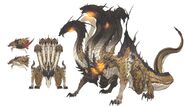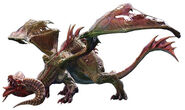The race of dragonkind is nigh immortal, with some creatures enduring through millennia of existence. These long-lived beings are often the majestic subjects of romanticized myth and legend, but for the peoples of Ishgard, dragons are historically seen as marauding beasts that serve only to perpetuate the horror of the Dragonsong War.
Dragons are a non-playable race featured in Final Fantasy XIV. Originating from the Dragonstar, these enigmatic spoken creatures have scalekin-like bodies that metamorphose with age, having many specialized forms. Biologically immortal, dragons store vast quantities of aether in their eyes through their long lives and pass on their history through song. Dragons communicate through a unique language called dragonspeak that is part verbal part psychic projection.
Notable members[]
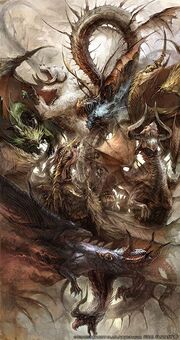
Midgarsormr and his first brood.
- Azdaja
- Bahamut
- Ehll Tou
- Ess Khas
- Faunehm
- Gullinbursti
- Hraesvelgr
- Marcelloix Mourelz
- Midgardsormr
- Nidhogg
- Ohl Deeh
- Orn Khai
- Ratatoskr
- Tiamat
- Vedrfolnir
- Vidofnir
- Vrtra
- Whei Ahf
Profile[]
Dragons lack a biological sex, instead choosing genders for personal preference or convenience. As such, each dragon is able to reproduce asexually, hatching dragonets that will grow to become full dragons in turn. Dragons, as creatures originally foreign to the star, are unique among the species that inhabit the Source in that their growth is marked by metamorphoses that can drastically alter their shape, size, and features.
Dragons can communicate over long distances and control scalekin through aether charged roars. These roars can also influence their children and descendants, which the great wyrm Nidhogg used to compel the Dravanian Horde to war against Ishgard during the Dragonsong War.
Dragonspeak, the language of the dragons, is a two part language; the verbal part has little in the way of grammar or tenses as it is supplemented by the psychic part, where intentionality and nuance is imparted.
Culture[]
While dragons do not require a mate to breed, they will often form pair bonds, connecting both emotionally and spiritually. These bonds have only ever been seen broken by the death of one of the mates. Dragons often are part of greater broods, communities and families determined by their sire, often connected directly with one of the first brood.
Dragons communicate their oral history through "song", sung in their dragonspeak, and give great importance to promises and slights done in the past, in timescales unimaginable to the peoples of Eorzea. Older dragons bear names in the common tongue, given to them in times of harmony by other spoken races, but younger dragons tend to have names rendered in dragonspeak. Some dragons can also speak the common tongue.
Physiology[]
Dragons have unique physiological characteristics compared to the rest of the species present on Hydaelyn, being capable of metamorphosing multiple times through their long lives. All dragons are born as dragonets but change into different classification of dragons, sometimes with wildly differing shapes, sizes, and even number of limbs. These forms are dependent on aptitude and specialization and the changes can happen at particularly important points in their lives.
The bodies of dragons are highly aether-rich, growing in this respect with age. Their eyes hold dense amounts of aether, can carry their influence even separated from their body, and can be used to empower others or transfer their power. Similarly, their blood carries aether that can be used to empower objects, such as the Order of the Knights Dragoon's signature Drachen armor, which is dipped in the blood of slain dragons.
Additionally, the consumption of dragon's eyes can empower mortals, with the side effect of leaving them and their descendants vulnerable to being subsumed by their newly inherited draconic nature when imbibing dragon blood.
Dragon forms[]
All dragons, regardless of their parentage, hatch as dragonets: small, winged, long tailed, horned, quadrupedal dragons. While in this form, dragons are considered children, although they can remain in this form for longer than human lifespans. Certain dragons have shown unique looking dragonet forms, with slightly differing proportions and horn shapes. Dragonets under standard development will develop into "full" dragons, striking the classic figure of a dragon with a large body, long neck, large wings and long, webbed tail, spiked backs and many horns. Further still, these dragons will metamorphose into elder dragons, a larger variant of the dragon.
Ehll Tou as a dragonet (above) and as a dragon grown (below), showcasing her species metamorphic nature.
However, many non-standard and specialized forms exist. A dragon can grow particularly in size, transforming into a type of dragon known as a wyrm, while a dragonet particularly adept at flying or wind magicks can grow into a wyvern, with large wings specially adapted for flight replacing their forelimbs. As they grow, wyvern bodies become more and more streamlined, losing their horns entirely by the time they become voivres. A voivre, also known as a wyvre, is further adapted for flight, with its lower limbs growing small and rarely, if ever, touching the ground. Further still wyvres can grow into falaks, who take serpentine forms that lack wings completely, staying aloft by mere wind aether manipulation.
Dragonets particularly attuned to earth magicks can grow into beings often called lesser or shield dragons, whose figures are bulkier and wings are smaller, with club-like tails and beastkin-like silhouettes. These types of dragons are rarely, if ever, seen flying. Along these lines, further specialized lesser dragons can transform into carapace, or armored dragons; large, lumbering, tortoise-like dragons whose carapace is nearly unpenetrable.
Lesser dragons can also metamorphose into the speedier brobinyaks and further still into verge or coeurl dragons, whose adaptation is credited to the Meracydian jungles, where wings would be a detriment and a coeurl-like form proves a boon.
Dragons can also metamorph into a form known as an amphiptere, whose forelimbs are partially wings and neck is more elongated, featuring long whisker-like protrusions from their heads.
A form, seemingly unique to the first brood, is that of the great wyrm, large and unique forms with varying characteristics, with different numbers of horns, coloration, potentially manes and feathers, although the silhouette and general shape remains draconic.
Ehll Tou is shown metamorphosing into a unique form, seemingly variation on the "full" dragon form, with a larger, more expressive face, and dextrous hands that allow her to work as a disciple of the land or hand.
Draconic humanoids[]
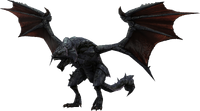
An Elezen turned aevis.
Mortals whose ancestors consumed the eyes of an elder dragon, are susceptible to draconic transfiguration by imbibing the blood of a dragon, turning them into dragon, or dragon-like creatures. The changes depend on how strong the concentration of draconic essence is in their blood.[note 1]
The most common of these are the aevis, named as such from the Enchiridion meaning of "devil who flies". Aevises are bipedal, draconic creatures with wings for forelimbs and a dragon-like face with rows of human teeth in front.
Another transformation, alternatively known as diresaur or giruveganus, is large and incapable of flight. They have feathered shoulders and large protruding horns, including one on its "nose". They are known to pummel walls and Ishgardian dragoons are said to take pleasure in slaying them.
Yet another creature that these people can transform into is the syrictas. Syrictae have lesser concentration of draconic essence in their body and as such their transformation is the furthest from a regular dragon, being a bipedal man-dragon, with long horns and spikes running down their backs. Their proportions are the most humanoid of the three known transformations.
Naming conventions[]
Dragon names come from either real-life mythological dragons, dragons from previous games in the series, creatures of Norse mythology, or are constructed from dragonspeak.
History[]
Origins on the Dragonstar and Midgardsormr's flight[]
Dragons as a species originated in the far off planet known only as the Dragonstar. Known as one of the strongest species in the universe, dragons lived among the planet's peaks in peace until they were attacked by a mechanical species known as the Omicrons. The Omicrons were an expansionary and invasive species that would subjugate planets for resources in an effort to "evolve" further and as a precautionary measure to eliminate threats to their continued existence. Seeing the dragons as the biggest threat to them, the Omicron invaders laid siege to the star, leading a protracted war against the dragons. During this period, dragon specimens were captured and studied by the Omicron Stigma-4 in an effort to learn of the dragons' adaptive evolution, being controlled and forcibly turned into mechanical hybrids to attack their own kind. This war eventually ended when the planet was rendered uninhabitable for new life, with newly hatched dragonets being malformed and suffering. At this point, remaining dragons were visited by the entelechy Meteion, who recorded their despair.
Among the dragons of the dragonstar was the great wyrm Midgarsormr, who, much to the scorn of his peers, fled the star with seven of his unhatched eggs, pursued by the Omicrons' greatest weapon, Omega, who he had fought to a standstill before. Flying through the great expanse of the sea of stars, Midgardsormr eventually reached the planet Hydaelyn, where he entreated with the divinity of the same name, who allowed him and his children to take refuge on the star, and tasked Midgarsormr with protecting Silvertear Lake. With his children's future secured, the great wyrm laid in deep slumber in Mor Dhona. The newly hatched first brood eventually spread throughout the world, siring broods of their own, establishing new communities, often coming into contact with the "mortals" who populated the world, with two of the largest settlements of dragons being in Dravania to the northwest of Aldenard and the southern continent of Meracydia.
Allagan expansion[]
Millennia later, when the languishing mortal Allagan Empire's first emperor, Xande, was resurrected by the scientist Amon, he began an expansion toward Meracydia, where the the great wyrms Tiamat and Bahamut of the first brood had made their home and spawned their own brood. The Allagan Empire attacked these dragons, and through the use of aetherochemistry and advanced warmachina eventually killed Bahamut. Through the machinations of the Ascians, a shadowy cabal that wished to resurrect their sealed god Zodiark by causing calamities on the star, Tiamat was convinced to summon a corrupted primal of her late brother-mate, under the impression that it would resurrect him. Given power by the dragons' worship, this Dreadwyrm Bahamut instead tempered the dragons that summoned it. However, thanks to the Ascians, the Allagans were given the means to capture the primal, deploying the Omicron Omega who had crash landed on the planet and was unearthed by them. With Bahamut sealed away in Dalamud, the Allagans conquered and enslaved the Meracydian dragons, cruelly experimenting with them until the Empire fell during an Umbral Calamity orchestrated by the Ascians.[1] During the full scale conflict with the Allagan Empire before its fall, the great wyrms Vrtra and Azdaja heeded Tiamat's call for help and fought against the voidsent servants that the Allagan Empire summoned from the void, whereupon Azdaja entered one of the voidgates in an effort to stop the empire, seeing herself trapped in the void.[2]
Dravanian–Ishgardian conflicts[]
Twelve hundred years before the Seventh Astral Era, conflicts between the Dravanian Horde and Ishgardian Elezen of Coerthas escalated. Of these two factions, the great wyrm Hraesvelgr and Saint Shiva fell in love. In hopes of always being together, Shiva allowed Hraesvelgr to consume her, body and soul. With this sacrifice, the conflicts between the two factions stopped and the mortals communed with the dragons for two hundred years, casting monuments, communities, and living harmoniously with each other.[3] However, when the great wyrm Ratatoskr confided with King Thordan I of her brother Nidhogg's disdain for the Ishgardians, King Thordan and his Knights Twelve descended upon her and slayed the great wyrm, consuming her eyes and essence in an effort to protect themselves from Nidhogg. Enraged by this trespass, Nidhogg fought Thordan and his knights, slaying the king and many of his knights before losing both his eyes to them. In impotent rage, Nidhogg entreated Hraesvelgr to confer one of his eyes to him in an as "penance" for trusting in the Elezen Nidhogg had long believed were untrustworthy. With his newly recovered strength, Nidhogg thus rallied the Dravanian Horde to fight against the Ishgardians in what would become known as the Dragonsong War.[4] During that time, Nidhogg orchestrated the war in such a manner that would never let Ishgardians have periods of peace, collectively punishing the entire people of Coerthas.
The Agrius and Garlean interference[]
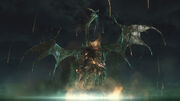
Midgarsormr consumed by the explosion.
As the Garlean Empire began its conquest of Aldenard during the waning Sixth Astral Era, the XIVth Imperial Legion mobilized the Agrius, their largest airship through Mor Dhona, headed towards the rest of Eorzea after conquering Ala Mhigo. However as the warship flew above Silvertear Falls, the great wyrm Midgardsormr rose from the lake, and with its roar called for the Dravanian Horde to mobilize against the warship and its attached warmachina. During this fight, the wyrm managed to bring down the airship, but in the process caused the eruption of its ceruleum supplies, being consumed within the explosion and seemingly dying, with his corpse decorating the centre of Mor Dhona, known now as the Keeper of the Lake.
Following this invasion's failure, the Garlean Empire employed the VIIth Imperial Legion to attempt to call down Dalamud to attempt to raze Eorzea, but instead freed the primal Bahamut, who'd grown incredibly powerful in the millennia since his imprisonment, powered both by the energy acquired from the sun and the continued worship of captured Meracydian dragons in the Binding Coils of Bahamut. However, rather than causing a long age of darkness and bringing about a longstanding Sixth Umbral Era, with the sacrifice of Louisoix Leveilleur, Bahamut was defeated before causing irreparable damage, leading to a 5 year long Umbral Era.
The end of the Dragonsong[]
During the late Sixth Astral Era, the Elezen Ysayle Dangoulain, a Walker, came upon Hraesvlgr in Coerthas, and experienced an Echo vision of Saint Shiva and Hraesvelgr. Believing this vision a revelation from Hydaelyn, Ysayle joined the Heretics, a splinter of Ishgardians who sided with the dragons and still worshipped Saint Shiva, and took the name "Lady Iceheart", learning how to summon a primal version of Shiva into herself, believing that she was summoning the spirit of the saint herself.
As the Dragonsong War came to its head, the Warrior of Light was joined by Lady Iceheart, Alphinaud Leveilleur. and the current Azure Dragoon, Estinien Wyrmblood, as they ventured into Dravania to plead with Hraesvelgr for peace between Dravanians and Ishgardians. Revealing the long buried truth of the conflict's origins, and that the primal Iceheart summoned was not the real Shiva, the group grew disillusioned that they could achieve lasting peace between their peoples. Following these revelations, Estinien and the Warrior of Light struck down Nidhogg in the Aery, discovering through the Echo that Nidhogg's eye remaining eye belonged to Hraesvelgr. Wishing to make known the truth of the war now that its main adherent was slain, the group was rebuffed by the Archbishop Thordan VII and the Heavens' Ward, who, thanks to Ascian machinations, were able to turn into primal versions of King Thordan I and his Knights Twelve. Following Thordan to Azys Lla, the group was accosted by the Garlean's VIth Imperial Legion, but were saved by Hraesvelgr and Ysayle, the latter of which sacrificed herself to defeat the Imperials.
Using one of eyes of Nidhogg, attached to the corpse of Haldrath, and drinking of the essence the Warring Triad imprisoned in Azys Lla, Thordan wished to continue their "holy war" against the dragons, but he and his compatriots were struck down by the Warrior of Light. Following the death of the Archbishop, Estinien gathered both Eyes of Nidhogg and became possessed by Nidhogg's shade, his rage and will surviving in his bloodsoaked armour and aether filled eyes. With Thordan and Nidhogg both dead, peace talks were attempted by Ishgardian and the dragons living in Anyx Trine, but were interrupted by the shade of Nidhogg that desired only vengeance. Once more mounting an offensive against Ishgard, Nidhogg fought against Hraesvelgr who had been convinced by the Warrior of Light to fight for peace between their peoples. Finally facing the Warrior of Light, empowered by one of Hraesvelgr's eyes, Nidhogg's shade was cast out of Estinien's body by the Warrior and Alphinaud with the help of the spirit of the departed Ysayle.
With Nidhogg's eyes separated from Estinien's body, they were cast from the Steps of Faith, with the belief that the torrent of unstable aether at the bottom of the chasm would keep them out of reach of meddling hands. However, the Ascian Elidibus obtained the eyes and orchestrated their use to summon the primal Shinryu.
Modern reconciliation[]
Following the death of Nidhogg, cooperation between Dravanians and mortals increased. With the aid of the Mogmenders and the Warrior of Light, areas in the Churning Mists were restored to their previous splendor. After the young child Maelie Greystone was rescued from certain death by Vidofnir, Ishgardian opinions on dragons improved. With the creation of the Firmament, transfigured former heretics were allowed to return to their families, and dragonets and other dragons were allowed to visit and live among the peoples of Ishgard.
Sometime before the return of the Final Days, the great wyrm Tiamat was freed from tempering by the Scions of the Seventh Dawn's efforts and freed from her ancient Allagan fetters. Following her freedom, Tiamat gathered the remains of her brood in Eorza and returned to Meracydia.
Having long abandoned hope of rescuing his sister Azdaja from the void of the Thirteenth, Vrtra had long since founded the city-state of Radz-at-Han, acting as satrap for the mortals there, considering them his brood. However, with the aid of the former Scions, Vrtra's hopes were renewed as he ventured deep into the void to rescue his sister, who was held captive by Golbez, a voidsent bent on opening a voidgate to the Source to bring salvation to the Thirteenth. Finally, reasoning with Golbez that he did not have to damn others to try and save his people with the aid of the half-voidsent Zero, Vrtra was able to save Azdaja by sacrificing one of his eyes, introducing her to their new home.
Gameplay[]
Dragons serve as a family of enemies in the game, encountered mainly in Coerthas, Dravania, and Allagan-related areas. Dragons also act as non-hostile NPCs. The dragon Vrtra, under the guise of Varshan, acts as a non-controllable character that can accompany the player character through certain dungeons through the use of the Duty Support system.
Various dragons appear in Triple Triad as cards. Dragons also feature as mounts and minions, the latter of which can be which can be deployed within Lord of Verminion.
Behind the scenes[]
Dragons were meant to be introduced properly in version 1.0 alongside Ishgard but were shelved when Ishgard could not be included in the initial release.
Gallery[]
Etymology[]
A dragon is a legendary creature, typically with serpentine or reptilian traits, which is featured in the myths of many cultures.
Notes[]
Annotations[]
- ↑ While not taxonomically dragons, these spoken creatures are often classified as such and as consequence are covered here. By definition they would more closely belong to the "transfigured" class of creature introduced in Encyclopædia Eorzea: The World of Final Fantasy XIV Volume III, which includes any living creature subjected to a permanent transformation by outside means.
Citations[]
- ↑
 Fetters of Lament
Fetters of Lament
- ↑
 A Brother's Grief
A Brother's Grief
- ↑
 Heart of Ice
Heart of Ice
- ↑
 The Song Begins
The Song Begins
References[]
- Video games
- Square Enix Product Development Division 3 (2013). Final Fantasy XIV [Game]. Square Enix. Microsoft Windows, Macintosh, PlayStation 3, PlayStation 4, PlayStation 5.
- Bibliography
- Banri Oda, Michael-Christopher Koji Fox, Natsuko Ishikawa (2016). Encyclopædia Eorzea: The World of Final Fantasy XIV [Book]. Square Enix. ISBN 978-1-6460-9142-3.
- Banri Oda, Michael-Christopher Koji Fox, Natsuko Ishikawa (2018). Encyclopædia Eorzea: The World of Final Fantasy XIV Volume II [Book]. Square Enix. ISBN 978-1-6460-9143-0.
- Banri Oda, Natsuko Ishikawa, Kenta Ishiguro (2023). Encyclopædia Eorzea: The World of Final Fantasy XIV Volume III [Book]. Square Enix. ISBN 978-1-64609-201-7.
- Websites
- Michael-Christopher Koji Fox (2015). "A Lesson in Dragonspeak". From Final Fantasy XIV Forum. Accessed 30 December 2023. Archived from the original on 11 March 2019.







